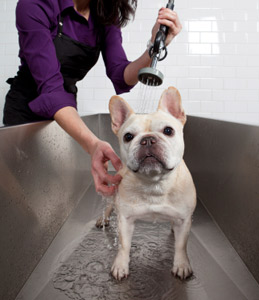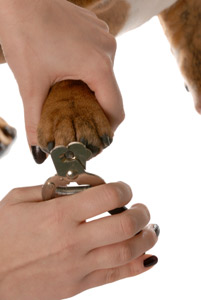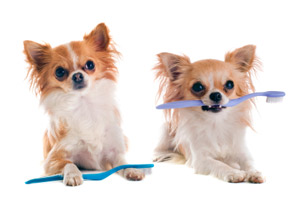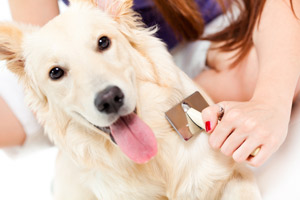Care Tips
1. Bathing
Bathing is an important part of the grooming process. How often your dog should have a bath depends on several factors, including what type of coat he/she has, how much time he/she spends outside, and simply how dirty he/she gets.
Really, it will be up to you to decide when to bathe your dog. Some dogs need a bath every 2 or 3 weeks, while other dogs can wait up to 6 weeks.
Some dogs love the water, while others hate it. Depending on your dog’s feelings, bath time can either be a happy, fun time or a messy, not-so-fun time.

If your dog does not like washing, you can help him/her calm down by talking or even singing. Your tone of voice will sooth him/her.
If you live in a hot climate and have garden, you can wash your dog outside using a garden hose. If you are washing your dog indoors, placing a plastic mat on the floor of the wash basin or shower will prevent slipping of your dog's feet and it will ensure that your dog firmly stands.
Be prepared for the fact that bathing a dog is a messy job and every inch of your bathroom is prone to some splashing! Have plenty of dry towels handy to wipe down the room when the bath is over. Gather together a mild dog shampoo, cotton balls, and a washcloth. Place your dog in the tub and saturate him/her with warm water (placing a cotton ball in each ear should keep the water out), making sure to wet him/her right down to the skin. A spray attachment may be helpful at this time, to make sure you wet every area of his body. Apply some shampoo, and start scrubbing, working the shampoo into a nice lather. When cleaning the face, use a damp washcloth and be careful not to get soap into his/her eyes. Then rinse his/her entire body thoroughly with warm water, being sure to get rid of every last bit of soap. If you’d like, you can follow this with a conditioning rinse
Once you are finished rinsing your dog, allow him/her to shake off any excess water, if possible. Then, towel dry him/her thoroughly. If his/her coat is very thick, you may want to use a hand-held blow dryer on a low setting to make sure he/she’s really dry.
2. Nail Clipping

Hearing your dog’s nails clicking on the floor is a good sign that it’s time for a clip. The nails should be even with the paw pad, and anything beyond that should be trimmed. Nails that are too long can put unnecessary stress on your dog’s paw by forcing weight onto the back of the pad. Long nails can also scratch skin, furniture, and other objects. You should consult your veterinarian when you notice that your dog's nails are too long.
3. Eye Cleaning
Your dog's eyes should be cleaned on a regular basis, as dogs are susceptible to many of the same eye conditions that are common in humans, including sties, allergies, and infections. If a dog's eyes are healthy, a clear mucus secretion is normal and should be wiped away with a soft-damp cloth. If the secretion is yellowish or bloody, your dog should be taken to the vet right away.

Many light-coloured dogs can develop brown tear stains underneath their eyes, usually caused by excess eye fluid that wets the fur around the eyes and allows various yeasts to flourish. To try to avoid these tear stains, keep your dog clean and keep the fur out of his/her eyes. There are also a number of commercial products that can help to remove any tear stains.
4. Ear Cleaning
Dogs with a lot of fur, such as poodles, tend to accumulate some fur growth in the ear canal that must be removed on a regular basis. You should consult your vet about this issue. If your dog develops an ear problem, he/she should exhibit certain symptoms. He/she may frequently shake his/her head, rub his/her ears on the floor, or scratch his/her ear with his foot. If you recognize these symptoms, you should visit your vet.
5. Brushing Teeth
Taking care of your puppy’s teeth and gums is very important, as about 80 percent of dogs develop some sign of gum disease by the age of three. These signs include loose or discolored teeth, bad breath, swollen gums, receding gum line, and gums that bleed easily. In additional to regular trips to the veterinarian, a great way to help keep your dog’s gums and teeth healthy is by brushing his teeth.
Most dogs will not be immediately comfortable with the idea of having their teeth brushed, so you will need to take a little time to get them used to it. Start by using your finger to gentle massage his gums, getting him/her used to having your finger in his/her mouth. You should also let him/her lick a tiny bit of the dog toothpaste so he/she’s familiar with the taste. Once he/she’s fairly comfortable, gently lift up his/her outer lips and use your finger to start massaging his/her bottom, top, and front gums in a circular motion.

After a few easy sessions of gum massage, it’s time to start brushing. You will need a pet toothbrush or some gauze to wrap around a finger, and some toothpaste specially designed for dogs. If you use a pet toothbrush, make sure you have one made especially for your dog’s mouth size. Start with just the front teeth and gradually add more teeth until all of them have been brushed. Focus on removing food residue from the outsides of the teeth, because your dog’s tongue can clean the inside surfaces well enough. If at all possible, your dog’s teeth should be brushed daily.
6. Grooming

Grooming is a major part of keeping your dog looking and feeling healthy. A matted coat can harbor all different kinds of skin conditions and will many times keep a problem from being noticed until it is too late.
Also, a dull or balding coat can be indicative of specific medical conditions, and regular coat inspections via grooming will allow you to notice when there is a change in your dog's coat. Massaging the dog's skin while brushing also stimulates blood circulation. Making sure every part of his/her body is kempt is also very important.
a. Smooth-Coated Dogs
Appearance is sleek and shiny. The following are some popular smooth-coated breeds:
Basset Hound, Beagle, Boston Terrier, Boxer, Bulldog, Dalmatian, Great Dane, Greyhound, Labrador Retriever, Miniature Pinscher, Pug, Rottweiler, Weimeraner.
Smooth-coated breeds make great pets for people who don't have a lot of time to devote to grooming. They require nothing beyond brushing and an occasional bath. While smooth-coated dogs don't need to be brushed every day, you should give your dog a good brushing as often as you can. In addition to helping to keep the oil evenly distributed over the coat and making sure the coat is free of shed hairs and dirt, brushing your dog is also a great way to bond with him/her. He/she will enjoy both the feeling of being brushed and the pleasure of spending time with you.
The basic tool you'll need for grooming is a bristle brush. To start brushing, follow the direction of the hair growth. Work your way from the head back toward the tail, using just enough pressure to stimulate the skin. Be especially careful when brushing your smooth-coated dog's belly and undersides.
b. Medium-Coated Dogs
A medium coat is generally longer than 2.5 centimeters, but still looks quite short. The following are some common medium-coated breeds:
Akita, Australian Shepherd, Border Collie, Brittany, Cavalier King Charles Spaniel, German Shepherd Dog, Golden Retriever, Great Pyreness, Pembroke Welsh Corgi, Saint Bernard, Siberian Husky.
Medium-coated breeds are also relatively easy to groom, as their coats generally don't get extremely dirty or develop mats. Some medium-coated breeds may require an occasional trim on the neck, ears, face, or feet, but generally, a good weekly brushing and a monthly grooming session will suffice. Give your dog a bath when necessary, and then, make sure he/she is completely dry. You can towel dry him/her, or even use a blow dryer on a low heat. Once he/she's dry, use a clipper or scissors to neaten the outline of his coat. Never clip for too long without stepping back and taking a look at your work! Medium coats don't require much trimming, so it's easy to over trim.
c. Long-Coated Dogs
Long-coated breeds can be divided into the following three categories: long parted coat, long-coated small breed dog, and long-coated large breed dog. Each type has slightly different grooming requirements.
i. Dogs with Long Parted Coat
Dogs with a long parted coat have long hair that should be parted in a very straight part along their back. Many people say that parting this kind of coat is the most difficult part of the grooming process. After you have bathed a dog with a long parted coat, towel dry and then blow dry it to keep it free from tangles. Once the coat is dry, stand behind the dog and place the tip of a comb just over the nose. Then, moving very slowly, comb over the crown of the head, down the neck, and back to the base of the tail, moving the hairs to the proper side to form the part as you go along. Once the part is perfectly straight, spray the entire coat with conditioner to set it.
There are only eight breeds that fall into this category:
Afghan Hound, Lhasa Apso, Maltese, Skye Terrier, Shih Tzu, Silky Terrier, Tibetan Terrier and Yorkshire Terrier.
ii. Long-Coated Small Breed Dogs
The long-coated small breed dog's hair is not parted along the back, but can still be quite challenging to groom. These breeds should be groomed daily.
After you've given your small breed dog a bath, towel dry his/her coat and then blow-dry it to avoid tangling. While blow drying, use a pin brush to continually brush and fluff. When the hair is completely dry, use scissors (or an electric clipper) to trim your dog's underside, clipping with the lay of the hair. Then, trim his paw pads and feet so the hair just reaches the ground around the paw. Finish by brushing and combing the hair on your dog's head and face.
The following are some popular long-coated small breed dogs:
Havanese, Chinese Crested, Pekingese, Pomeranian
iii. Long-Coated Medium and Large Breed Dogs
The grooming requirements of long-coated large breed dogs are similar to those of long-coated small breed dogs. The only real difference is that long-coated medium and large breed dogs are more likely to spend time outside, so they will probably have more dirt and tangles in their coat. To groom your long-coated large breed dog, give him a bath and then towel dry his/her coat. Then, thoroughly blow-dry his/her entire coat, working with a pin brush at the same time, brushing and fluffing, making sure not to miss any tangles or snags. Clip your dog's undersides and paws with scissors, and then brush and comb the hair on his/her face and head.
The following are some examples of popular long-coated medium and large breed dogs;
Bearded Collie, Chow Chow, Cocker Spaniel, Irish Setter, Newfoundland, Old English Sheepdog, Saint Bernard, Samoyed.
d. Wire-Haired Dogs
Wire (or broken) coats are not supposed to be soft and silky, like the coats of most other dogs. A properly groomed wire coat will be rough and bristly. The wire coat does not shed, which makes wirehaired breeds good choices for some allergy sufferers.
The following is a list of some common wirehaired breeds:
Affenpinscher, Border Terrier, Brussels Griffon, Dandie Dinmont Terrier, Irish Terrier, Otterhound, Scottish Terrier, West Highland White Terrier.
e. Wavy Coat
The wavy coat is characterized by curls, which is why it is often referred to as the curly coat. This type of coat tangles and knots easily and has a tendency to become dry. Before brushing your wavy-coated dog, you should always spray him with some sort of conditioning spray to avoid breakage.
Grooming a dog with a wavy coat can be difficult, seek specific advice from a veterinarian or professional groomer.
The following are some examples of common breeds with wavy coats;
Bichon Frise, Curly-Coated Retriever, Irish Water Spaniel, Komondor, Poodle, Portuguese Water Dog.